S
Saiph
Guest
So, I was digging around my backed up computer files for some old Baldur's Gate 2 characters, and I stumbled upon some pictures of the Trifid Nebula (M20) I took back in 2003. Now, here's the part I want to brag about 
The pictures were taken on a 24" telescope located at the summit of Mauna Kea, the old University of Hawaii telescope to be exact. They were part of my final paper/exam for an observational astrophysics class I was taking there over the summer. So, a few tidbits about the nebula itself, then the pictures:
The Trifid nebula is an Emission Nebula (with some reflecting portions) located in the constellation Sagittarius. The hydrogen gas is excited by the ultraviolet radiation of the bright stars in the center of the images. The three distinct strips of dust and gas that trisect the nebula are the source of the nebula’s name “Trifid” as coined by John Herschel. The distance to M20 varies quite a bit between sources. SEDS lists the distance as anything from 3000-9000 ly. It's approximately 25ly across, though that's obviously hard to figure considering the range in distance cited.
The picture itself was a bit of a challenge to take. The bright central stars were the key problem. Any exposure time long enough to bring out the features of the nebula saturated the core stars, which began to bleed over into the central nebula features. So this is actually a composite of 4 images, a red, blue, green, and clear image. This isn't that unusual of course, as CCD's are all black and white, so you have put filters in front and take multiple images, then combine them in processing. Even modern digital cameras (who also have ccd's) do this. They just have more of it hard-wired in, with all sorts of tricks I know nothing about.
The process is actually a bit more involved than just snapping pictures with filters in place though. Each color had a "flat field" image taken earlier in the night, during twilight hours. At that time, there's enough ambient sunlight left that the telescopes can't detect stars, and over the small area the telescopes observe it creates a "flat" field of light that can be used to help calibrate the images. Due to the structure of the telescope, and various lenses in the camera's the light doesn't fall evenly on the CCD. Some area's get less light, some areas get more. If you don't account for this, you can get an artificially brighter or dimemr star, just because of where it lands on the chip, not because of any real causes. This is a multiplicative effect usually, so you divide the entire image with this flatfield to "flatten it". The effect is really obvious when you do the processing, as the darker regions and lighter regions seem to snap into a more uniform distribution, often clearing the image up nicely.
The other calibration image you have to take is a "dark" image of, essentially, the back of the lense cap. This is an image with no light at all allowed to fall on the CCD chip, and it's purpose is to identify the baseline counts of all the pixels on the chips. Some will register photon hits without any outside influence, be it from mild electrical discrepencies, or just the chips own thermal heat signature (Thermal heat is IR light after all). So you have to subtract these spurious counts from the overall image to make sure you're only counting photons from the sky.
here's the first version of the color composite image, without any tweaking:
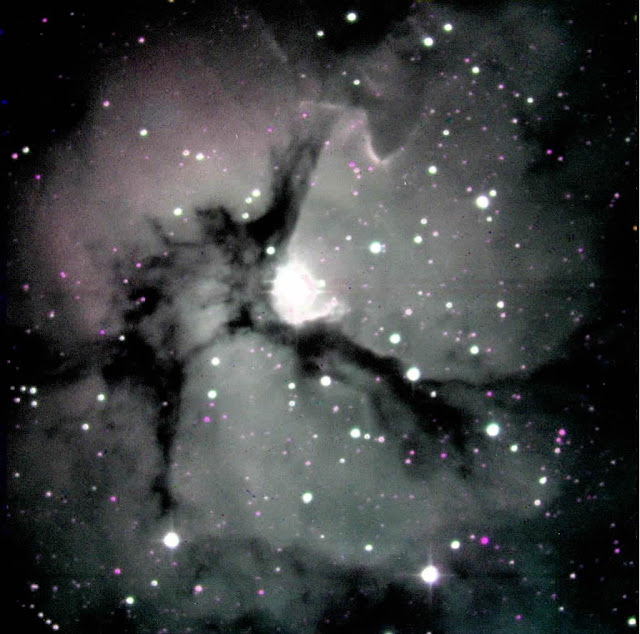
And here's a few other versions, with different scaling on the colors and a little post processing magic. Mostly they're attempts to bring contrast to the image so you can see the finer details, and to bring out that pesky blue. For some reason the blue didn't show very well in the image, probably requiring a longer blue frame exposure time. I couldn't get it to 'pop' with processing tricks back then though. If it had shown up you see a little less of the magenta stars, and a blue haze near the core where the nebulae acts as a reflection nebula (which predominately reflects blue light):
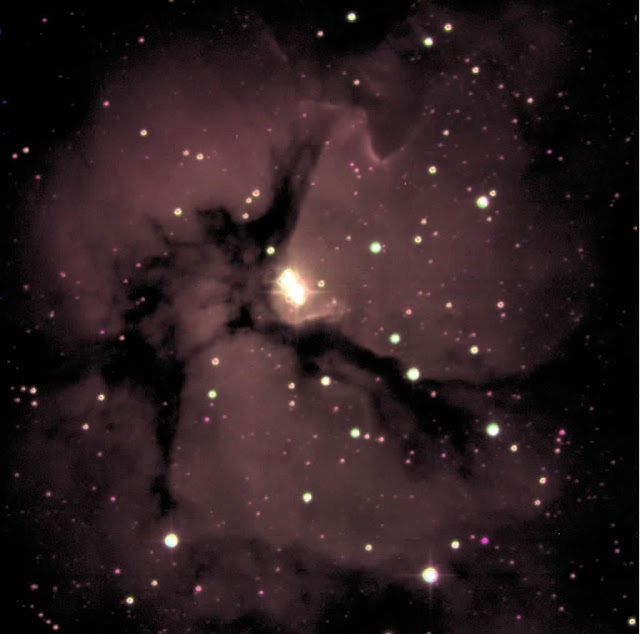
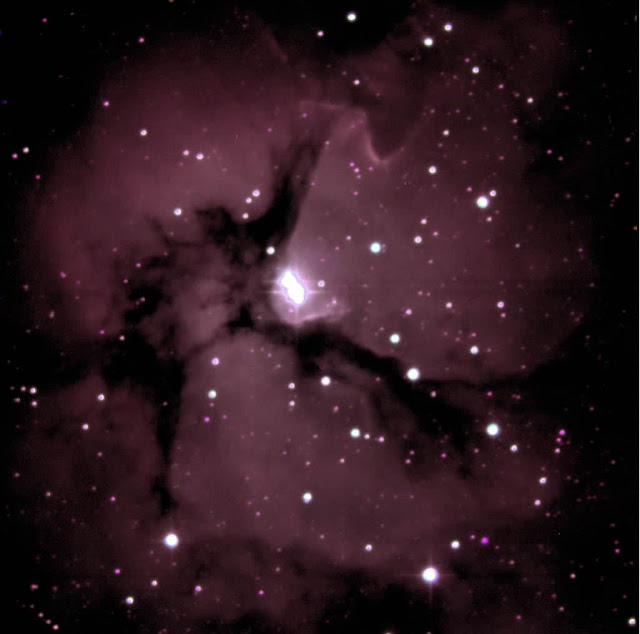
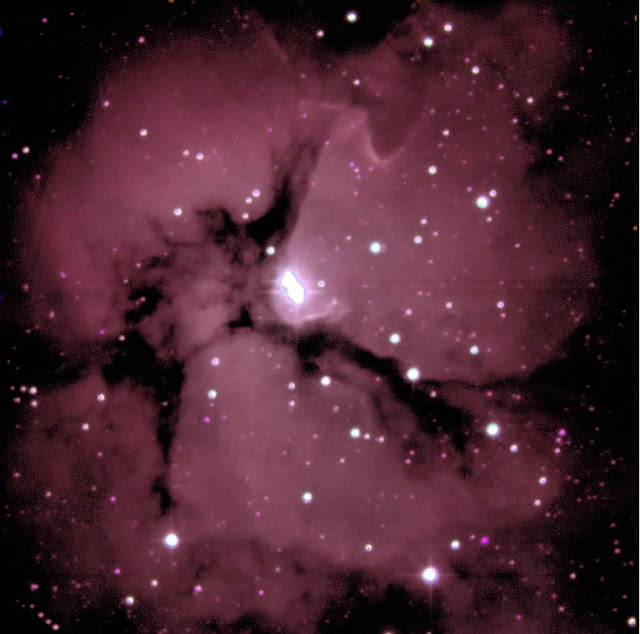
And here's a B&W image taken of M82 at the beginning of the course. Here you can see a few things that the dark and flat field images could have taken care of. For instance you'll notice some faint blackish rings just below the galaxy, those disappear with a proper flat field. And in the lower right corner, that was a readout streak that may have shown up on the dark, and thus disappeared if it was a consistent error on the chip (could have been a one time deal, I don't recall).
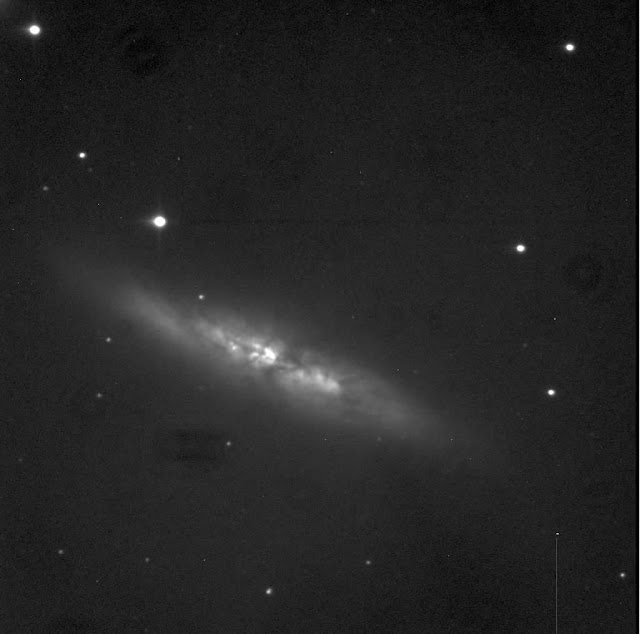
The pictures were taken on a 24" telescope located at the summit of Mauna Kea, the old University of Hawaii telescope to be exact. They were part of my final paper/exam for an observational astrophysics class I was taking there over the summer. So, a few tidbits about the nebula itself, then the pictures:
The Trifid nebula is an Emission Nebula (with some reflecting portions) located in the constellation Sagittarius. The hydrogen gas is excited by the ultraviolet radiation of the bright stars in the center of the images. The three distinct strips of dust and gas that trisect the nebula are the source of the nebula’s name “Trifid” as coined by John Herschel. The distance to M20 varies quite a bit between sources. SEDS lists the distance as anything from 3000-9000 ly. It's approximately 25ly across, though that's obviously hard to figure considering the range in distance cited.
The picture itself was a bit of a challenge to take. The bright central stars were the key problem. Any exposure time long enough to bring out the features of the nebula saturated the core stars, which began to bleed over into the central nebula features. So this is actually a composite of 4 images, a red, blue, green, and clear image. This isn't that unusual of course, as CCD's are all black and white, so you have put filters in front and take multiple images, then combine them in processing. Even modern digital cameras (who also have ccd's) do this. They just have more of it hard-wired in, with all sorts of tricks I know nothing about.
The process is actually a bit more involved than just snapping pictures with filters in place though. Each color had a "flat field" image taken earlier in the night, during twilight hours. At that time, there's enough ambient sunlight left that the telescopes can't detect stars, and over the small area the telescopes observe it creates a "flat" field of light that can be used to help calibrate the images. Due to the structure of the telescope, and various lenses in the camera's the light doesn't fall evenly on the CCD. Some area's get less light, some areas get more. If you don't account for this, you can get an artificially brighter or dimemr star, just because of where it lands on the chip, not because of any real causes. This is a multiplicative effect usually, so you divide the entire image with this flatfield to "flatten it". The effect is really obvious when you do the processing, as the darker regions and lighter regions seem to snap into a more uniform distribution, often clearing the image up nicely.
The other calibration image you have to take is a "dark" image of, essentially, the back of the lense cap. This is an image with no light at all allowed to fall on the CCD chip, and it's purpose is to identify the baseline counts of all the pixels on the chips. Some will register photon hits without any outside influence, be it from mild electrical discrepencies, or just the chips own thermal heat signature (Thermal heat is IR light after all). So you have to subtract these spurious counts from the overall image to make sure you're only counting photons from the sky.
here's the first version of the color composite image, without any tweaking:

And here's a few other versions, with different scaling on the colors and a little post processing magic. Mostly they're attempts to bring contrast to the image so you can see the finer details, and to bring out that pesky blue. For some reason the blue didn't show very well in the image, probably requiring a longer blue frame exposure time. I couldn't get it to 'pop' with processing tricks back then though. If it had shown up you see a little less of the magenta stars, and a blue haze near the core where the nebulae acts as a reflection nebula (which predominately reflects blue light):



And here's a B&W image taken of M82 at the beginning of the course. Here you can see a few things that the dark and flat field images could have taken care of. For instance you'll notice some faint blackish rings just below the galaxy, those disappear with a proper flat field. And in the lower right corner, that was a readout streak that may have shown up on the dark, and thus disappeared if it was a consistent error on the chip (could have been a one time deal, I don't recall).



